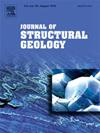一般的压迫和压迫
IF 2.9
2区 地球科学
Q2 GEOSCIENCES, MULTIDISCIPLINARY
引用次数: 0
摘要
本文提出了一种三斜挤压和拉伸模型,其中流动的同轴部分是一般的,既包括收缩和平坦,也包括纯剪切。结果表明,对于拉伸和变形,控制模型的变量的不同组合可以在变形图的所有场中获得有限应变椭球,包括长形椭球和扁形椭球。在每种情况下,控制有限应变椭球形状的主要是简单剪切方向与挤压(压转)或下沉(压转)方向之间的ζ角,以及涡度的大小和流体同轴部分的特性。有限应变椭球的主轴(X, Y, Z)的方向也随ζ的变化而变化。该模型已应用于自然实例,提高了对其运动演化和构造解释的认识。本文章由计算机程序翻译,如有差异,请以英文原文为准。
General transpression and transtension
In this work, a triclinic transpression and transtension model is presented in which the coaxial part of the flow is general, including both constriction and flattening as well as pure shear. The results show that, for both transtension and transpression, the different combinations of the variables that control the model allow obtaining finite strain ellipsoids in all fields of the deformation diagram, including prolate and oblate ellipsoids. It is mainly the ζ angle between the simple-shearing direction and the extrusion (transpression) or sinking (transtension) direction, together with the value of the vorticity, and the characteristics of the coaxial part of the flow, which controls the shape of the finite strain ellipsoid in each case. The orientations of the principal axes (X, Y, Z) of the finite strain ellipsoids show a wide variation, also dependent on ζ. The model has been applied to natural examples, improving the knowledge of their kinematic evolution and tectonic interpretation.
求助全文
通过发布文献求助,成功后即可免费获取论文全文。
去求助
来源期刊

Journal of Structural Geology
地学-地球科学综合
CiteScore
6.00
自引率
19.40%
发文量
192
审稿时长
15.7 weeks
期刊介绍:
The Journal of Structural Geology publishes process-oriented investigations about structural geology using appropriate combinations of analog and digital field data, seismic reflection data, satellite-derived data, geometric analysis, kinematic analysis, laboratory experiments, computer visualizations, and analogue or numerical modelling on all scales. Contributions are encouraged to draw perspectives from rheology, rock mechanics, geophysics,metamorphism, sedimentology, petroleum geology, economic geology, geodynamics, planetary geology, tectonics and neotectonics to provide a more powerful understanding of deformation processes and systems. Given the visual nature of the discipline, supplementary materials that portray the data and analysis in 3-D or quasi 3-D manners, including the use of videos, and/or graphical abstracts can significantly strengthen the impact of contributions.
 求助内容:
求助内容: 应助结果提醒方式:
应助结果提醒方式:


